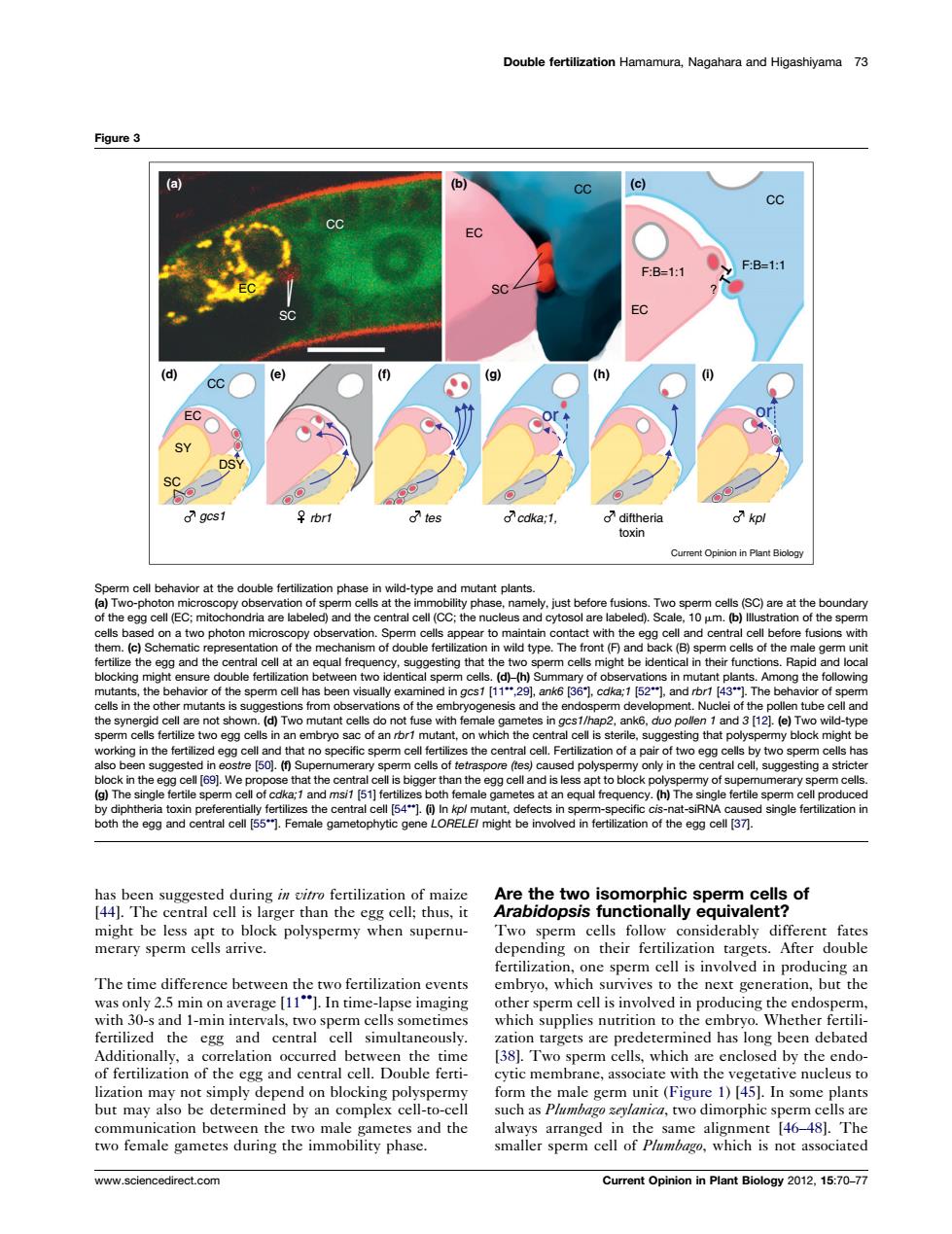正在加载图片...

Double fertilization Hamamura.Nagahara and Higashivama 73 Figure 3 (a) (d) CC acs ion in Piant Bio at th nt cel e of cdka:1 a y (h)The the egg and central cell [55"].Female gametophytic gene might be involved in fertilization of the egg cell [37]. sted during in fertilizati maiz 441.The cenual celis than the sel thus.it After doub The time difference between the two fertilization events n In time-lap imagin 38.Two sperm cells,which are enclosed by the endo tion and Current Opinion in Plant:70-77has been suggested during in vitro fertilization of maize [44]. The central cell is larger than the egg cell; thus, it might be less apt to block polyspermy when supernumerary sperm cells arrive. The time difference between the two fertilization events was only 2.5 min on average [11]. In time-lapse imaging with 30-s and 1-min intervals, two sperm cells sometimes fertilized the egg and central cell simultaneously. Additionally, a correlation occurred between the time of fertilization of the egg and central cell. Double fertilization may not simply depend on blocking polyspermy but may also be determined by an complex cell-to-cell communication between the two male gametes and the two female gametes during the immobility phase. Are the two isomorphic sperm cells of Arabidopsis functionally equivalent? Two sperm cells follow considerably different fates depending on their fertilization targets. After double fertilization, one sperm cell is involved in producing an embryo, which survives to the next generation, but the other sperm cell is involved in producing the endosperm, which supplies nutrition to the embryo. Whether fertilization targets are predetermined has long been debated [38]. Two sperm cells, which are enclosed by the endocytic membrane, associate with the vegetative nucleus to form the male germ unit (Figure 1) [45]. In some plants such as Plumbago zeylanica, two dimorphic sperm cells are always arranged in the same alignment [46–48]. The smaller sperm cell of Plumbago, which is not associated Double fertilization Hamamura, Nagahara and Higashiyama 73 Figure 3 (a) (b) (c) (d) (e) (f) (g) (h) (i) CC CC CC EC EC SC EC ? F:B=1:1 F:B=1:1 EC CC SC SY SC DSY gcs1 rbr1 tes cdka;1, kpl diftheria toxin or Current Opinion in Plant Biology or Sperm cell behavior at the double fertilization phase in wild-type and mutant plants. (a) Two-photon microscopy observation of sperm cells at the immobility phase, namely, just before fusions. Two sperm cells (SC) are at the boundary of the egg cell (EC; mitochondria are labeled) and the central cell (CC; the nucleus and cytosol are labeled). Scale, 10 mm. (b) Illustration of the sperm cells based on a two photon microscopy observation. Sperm cells appear to maintain contact with the egg cell and central cell before fusions with them. (c) Schematic representation of the mechanism of double fertilization in wild type. The front (F) and back (B) sperm cells of the male germ unit fertilize the egg and the central cell at an equal frequency, suggesting that the two sperm cells might be identical in their functions. Rapid and local blocking might ensure double fertilization between two identical sperm cells. (d)–(h) Summary of observations in mutant plants. Among the following mutants, the behavior of the sperm cell has been visually examined in gcs1 [11,29], ank6 [36 ], cdka;1 [52], and rbr1 [43]. The behavior of sperm cells in the other mutants is suggestions from observations of the embryogenesis and the endosperm development. Nuclei of the pollen tube cell and the synergid cell are not shown. (d) Two mutant cells do not fuse with female gametes in gcs1/hap2, ank6, duo pollen 1 and 3 [12]. (e) Two wild-type sperm cells fertilize two egg cells in an embryo sac of an rbr1 mutant, on which the central cell is sterile, suggesting that polyspermy block might be working in the fertilized egg cell and that no specific sperm cell fertilizes the central cell. Fertilization of a pair of two egg cells by two sperm cells has also been suggested in eostre [50]. (f) Supernumerary sperm cells of tetraspore (tes) caused polyspermy only in the central cell, suggesting a stricter block in the egg cell [69]. We propose that the central cell is bigger than the egg cell and is less apt to block polyspermy of supernumerary sperm cells. (g) The single fertile sperm cell of cdka;1 and msi1 [51] fertilizes both female gametes at an equal frequency. (h) The single fertile sperm cell produced by diphtheria toxin preferentially fertilizes the central cell [54]. (i) In kpl mutant, defects in sperm-specific cis-nat-siRNA caused single fertilization in both the egg and central cell [55]. Female gametophytic gene LORELEI might be involved in fertilization of the egg cell [37]. www.sciencedirect.com Current Opinion in Plant Biology 2012, 15:70–77�������������